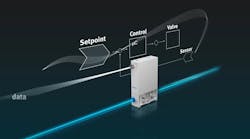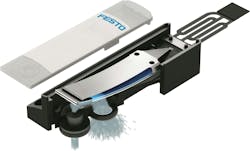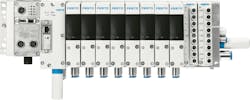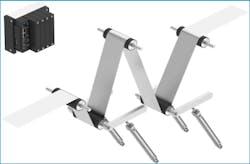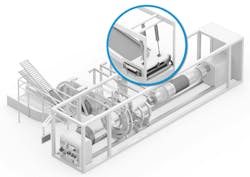Since introducing its first product featuring piezoelectric technology in 2017, the VTEM motion terminal, Festo Corp. has continued to work with and advance the technology to enhance pneumatic control.
Its work with piezoelectric technology has culminated in the recent introduction of a family of products, called Controlled Pneumatics, which combine proportional technology, sensors, and control algorithms into a closed-loop control system capable of providing improved precision and efficiency.
A key part of these systems is Festo’s piezoelectric valves which work on the general principle of piezo technology — applying enough force to a material to create power. “In using that concept, we've taken it and applied power to a [conductive] material, and it bends in proportion to the voltage we're applying,” explained Daniella Gonzalez, Product Market Manager Pneumatics, Valves, at Festo Corp.
Within the piezoelectric valve a ceramic bender is attached to the voltage supply. Applying voltage to the bender causes it to move and open a path through which air can flow. The amount of voltage applied determines how much the bender moves and thus how much air flows through the system.
Pairing this capability with developments Festo has made in processor, sensor and controller technology enables more efficient and precise pneumatic control in a range of applications.
How Controlled Pneumatics Benefit from Piezoelectric Technology
Per Festo, its Controlled Pneumatics systems are comprised of digitally controlled proportional pressure regulators, sensors, high-speed communications, and control algorithms. The proportional pressure regulators include the company’s piezoelectric valves which provides a number of performance benefits.
Gonzalez said piezoelectric technology offers energy savings, long service life as well as minimal noise and heat generation. The reduced energy use enables the Festo piezoelectric valves to consume 95% less energy than solenoid valves, helping to reduce energy consumption in the overall system and operation.
By using less energy, emissions from electricity generation can be reduced as well as operational costs. Sustainability is becoming increasingly more important to companies, and more energy efficient technologies are a way they can meet their environmental goals.
Low friction and the lack of heat generation associated with piezoelectric technology minimizes wear, helping to extend the lifespan of the valves and thus the system into which they are integrated. These benefits also enable the piezoelectric valves to be densely packed, allowing creation of compact packages capable of fitting into space constrained applications.
Another advantage offered by the piezoelectric valves is their ability to open proportionally, providing precise control of pressure and flow. The valves are also fast acting which can benefit a number of highly dynamic applications. These capabilities not only benefit accuracy and productivity but can help with energy conservation efforts as well.
Watch the video below from Festo to learn more about its piezoelectric technology.
Gonzalez noted the technology is not always going to be used as a replacement for traditional solutions such as solenoid valves but can be used in addition to them.
“It is going to give you the ability to do things that you cannot do sometimes with solenoid valves traditionally,” she said. “Not every valve can be replaced by a piezoelectric valve but there are a lot of applications that today are made with traditional solutions and could be improved [by using] a product from the piezoelectric catalog.”
For instance, if a machine contains a lot of pressure regulators it can be time consuming to adjust and set the parameters for all of the regulators. By instead using a product like the VTEM motion terminal which allows control of up to 16 channels with one valve manifold, machine operators simply need to change the settings on their PLC (programmable logic controller) and everything is then adjusted as needed. This saves a lot of time for the operator.
“Those are some applications where we've been successful replacing traditional pneumatics with piezoelectric components,” said Gonzalez.
A Good Mix of Electric and Pneumatic Performance Characteristics
Aiding the precision of the piezoelectric valves is the closed-loop control strategy Festo employs in its Controlled Pneumatics products. Per Festo, closed-loop control of the piezoelectric valves ensures an accurate, stable, and linear flow rate — without hysteresis. Repetition accuracy is rated at +/-0.25% of the setpoint, ensuring consistent operation where required.
The control loop is done inside what Gonzalez said she likes to call a magic black box into which sensors and controllers are built. This enables the black box to handle all necessary calculations for a given application.
Essentially, all a user needs to do is enter their desired parameters and turn on the air, and the system will take care of the rest. Not only does this help to simplify setup but also aids flexibility said Gonzalez. Immediate adjustments to specified setpoints can be made during operation while the ability to utilize presets enable fast format changeovers.
She said Controlled Pneumatics can benefit those applications where multiple flows are required from a compact solution and pointed to tension control for printing newspapers or wrapping paper towel rolls as an example.
Proper tension control ensures a consistent product and has typically relied on traditional pneumatic solutions. However, the process may need to be paused or manual work undertaken — which can be unsafe in such an application — to make adjustments.
The Controlled Pneumatics technology, on the other hand, offers more flexibility by allowing adjustments to be made on the fly without pausing the operation or doing manual work. “Having something that will be far [from the machine] that you can adjust and still control the tension will be very important,” said Gonzalez for maintaining safety and productivity.
She said Controlled Pneumatics really shines in highly dynamic applications requiring precise control.
Gonzalez noted that when thinking of precision in motion control, electric solutions often come to mind first for many customers. Depending on the application and the size, electric options can be more expensive. She said Controlled Pneumatics bypasses this issue because it combines the accuracy of electric motion with the familiarity of traditional pneumatics, which are also typically a lower cost option. “So, it’s a good mix,” she said.
While it depends on the application at hand and its specific requirements, Gonzalez said the precision offered by Festo’s Controlled Pneumatics solutions is comparable with that provided by electric options.
Successful Application of Controlled Pneumatics
Festo has deployed its Controlled Pneumatics products in a number of applications where Gonzalez said they have demonstrated successful results.
Welding, surface processing, dispensing and pumping, PET bottle blowing, and diaphragm pump control are other applications for which the company sees its Controlled Pneumatics technology being a good fit.
In general, applications requiring precision, control and a long service life are those in which Festo’s Controlled Pneumatics featuring piezoelectric technology will prove most beneficial.
